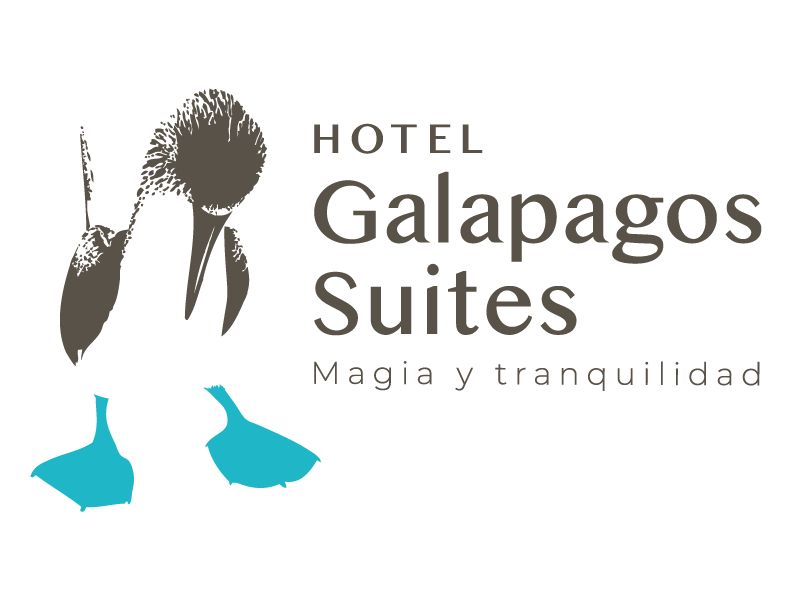TIPS FOR YOUR DAILY TOURS
Before traveling, you will need to know the following information.
WEATHER
You will experience a range of different temperatures, which can be unpredictable. In the Galápagos, the islands are very misty from May through November, when there is constant moisture called, “garua.” It tends to be very warm and humid from November to April, so be sure to dress accordingly and don’t forget your sunglasses, sun block, hat, and a rain jacket if it’s garua season!!
CLOTHING
In the Galápagos, you will have snorkeling opportunities, be sure to remember and bring your swimsuit. We highly recommend bringing your own mask, especially if you need a prescription mask! Galapagos walks will include terrain covered in sand, lava, boulders, and compacted volcanic ash.
Island landings will include both wet (on beaches) and dry (on lava), so you will need a good pair of shoes (tennis shoes or other closed shoes, closed tevas/keen are suggested).
The Bay Tour offers panoramic views of the island’s coastline and volcanic landscapes, snorkeling in open sea and go to the iconic “Las Grietas” place.
Bay Tour
Bay Tour in Puerto Ayora, Galapagos, is a popular excursion that offers a fantastic way to explore the diverse marine life and stunning natural scenery around Santa Cruz Island. Here are some highlights of the tour:
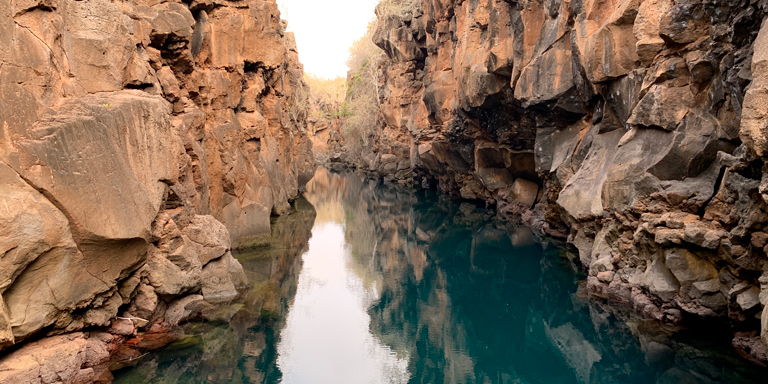
1. Las Grietas: This is a series of stunning lava rock formations creating deep, clear water crevices perfect for swimming and snorkeling. The brackish water here is a mix of sea and freshwater, providing a unique experience.
2. Isla Lobos: A small islet that is home to playful sea lions. Snorkeling here offers the chance to interact closely with these curious animals.
3. Canal del Amor (Channel of Love): A picturesque narrow waterway surrounded by steep cliffs. It is often visited for its serene beauty and romantic ambiance.
4. Las Tintoreras: Another area where white-tip reef sharks can be seen. The name «Tintoreras» refers to these sharks.
This Tour typically lasts around 3-4 hours and includes opportunities for snorkeling, swimming, and wildlife observation. It’s an excellent way to experience the unique ecosystems of the Galapagos in a relatively short amount of time.
Bartolome Island
This is the classic spot of the Galápagos. The view from the top of the island of the volcanic landscape is spectacular. It is reached by a series of flights of wooden steps and is the most photographed view in Galápagos. Pinnacle rock is the eroded remains of a tuff cone. A small, submerged crater can be seen just offshore. To the east you can see a series of small spatter cones. You may swim from the beach of the north side of the island and the snorkeling is excellent close to Pinnacle Rock.
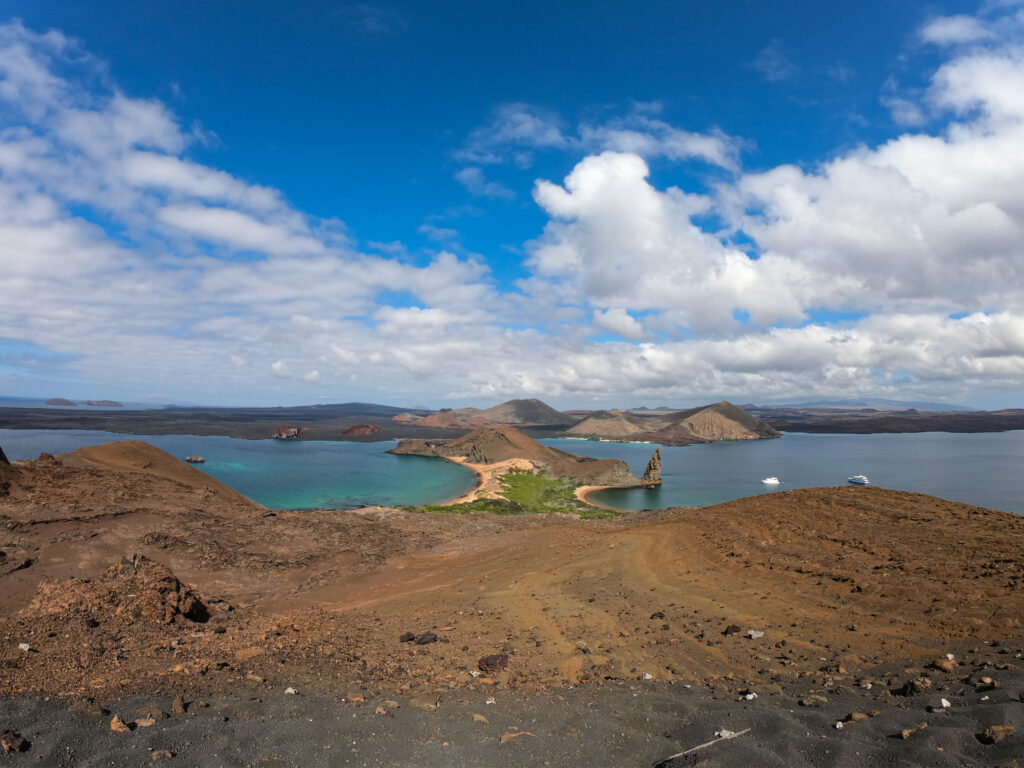
WATCH OUT FOR:
Galápagos Penguin, Galápagos Hawk, White-tipped Shark, Green Turtle, Ghost Crab.
Grey Matplant, Saltbush, Lava Cactus, Prickly Pear, Galápagos Spurge, Beach Morning Glory, Mollugo, Stewart’s Scalesia, Spiny Bush.
Pick up time: 6:00 -7:00 :00 from the hotel or meeting point
Drop off time: 16:00 at the hotel or meeting point
Includes: transportation, breakfast in some of the boats, naturalist guide and lunch
Recomendation: bring light clothing, sunscreen, a hat, water, comfortable walking shoes, a swimsuit, and snorkeling gear.
Santa Fe
The visiting site on Santa Fe is on the northeastern corner of the island. The anchorage is very sheltered, being protected by a small cactus covered islet, “Islote Black”, named after the late Juan Black, one of the first Directors of the Galapagos National Park. The bay is quite shallow and you can often see sting rays and green turtles in the clear water. There is good snorkeling around Islote Black.
Santa Fe is noted for its large colony of Sea Lions that live on the white sand beaches at the head of the bay. Visitors often have to find their way around groups of sleeping cows and pups. Be careful of the bull Sea Lion or beachmaster. He is normally not very aggressive, but can be during the breeding season. The trail should give you the opportunity to view the Santa Fe Land Iguana, found only on this island, and the delightful endemic rice rat, which is particularly in evidence towards sunset.
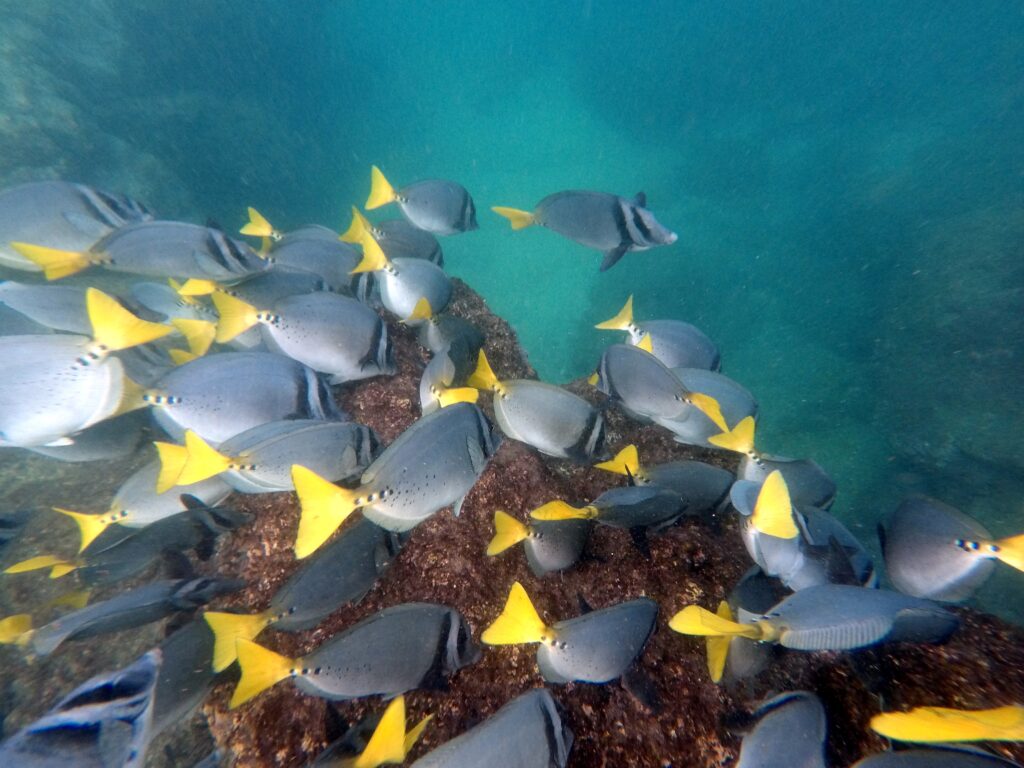
WATCH OUT FOR:
Galapagos Sea Lion, Sand Dollar, Ghost Crab, Galapagos Rice Rat, Galapagos Hawk, Ground Finches, Cactus Finches and Land Iguanas. Palo Santo, Muyuyo, Galapagos Lantana, leatherleaf, Prickly Pear Cactus, Salt Bush Spiny Bush, Galapagos Croton.
Pick up time: 7:00-8:30 from the hotel or meeting point
Drop off time: 16:30 at the hotel or meeting point
Includes: transportation, naturalist guide and lunch
Recomendation: bring light clothing, sunscreen, a hat, water, comfortable walking shoes, a swimsuit, and snorkeling gear.
Seymour Island
Lying just to the north of Baltra, Seymour is a small island consisting of uplifted submarine lava. It is cover with a forest of Dwarf Palo Santo trees and is the breeding site of both frigatebirds and two of the boobies. The trails lead from the small dock along the coast, past an area where Marine Iguanas nest and then loops into the Palo Santo Forest past nesting frigatebirds and both Nazca and Blue footed Boobies.
The Land Iguanas here are actually from Baltra from where they were brought in the 1930’s. Some have recently been returned to Baltra as the original population was wiped out during the period that Baltra was a US military base. You can often see young Sea Lions surfing in the large waves off the rocky beach.
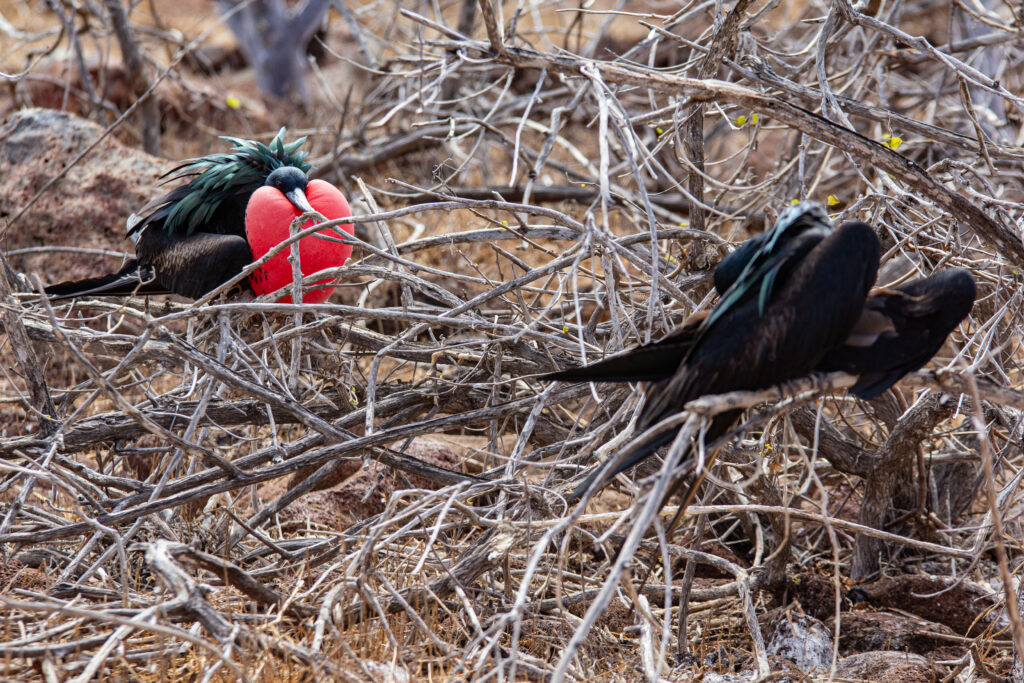
WATCH OUT FOR:
Galapagos Sea Lion, Marine Iguana, Land Iguana, Lava Lizard, Stripped Galapagos Snake, Great Frigatebird, Magnificent Frigatebird, Blue-footed Boobie, Nazca Boobie, Brown Pelican, Swallow-tailed Gull, Lava Gull, Common Noddy, Ground Finches. Dwarf Palo Santo, Parkinsonia, Prickly Pear Cactus, Muyuyo, Leatherleaf, Saltbush, Spiny Bush, Galapagos Carpetweed, Sea Purslane, Galapagos Croton.
Pick up time: 7:00-8:30 from the hotel or meeting point
Drop off time: 16:00 at the hotel or meeting point
Includes: transportation, naturalist guide and lunch
Recomendation: bring light clothing, sunscreen, a hat, water, comfortable walking shoes, a swimsuit, and snorkeling gear.
Plazas Island
Plaza islands lie just off the eastern tip of Santa Cruz. They are formed from uplifted marine lava. Only the southern of the two islands is open to visitors, but this is one of the most concentrated wildlife sites in the islands.
The trail takes you up from the small dock, frequently occupied by Sea Lions, past the rather droopy Prickly Pear Cacti with their yellow flowers, and up to the cliff from where you can often see a shoal of the endemic Yellow-tailed Mullet. The cliff is an excellent place to view the Swallow-tailed Gull and the Red-billed Tropic Bird, both of which breed here, and which along with boobies and frigates use the updraft for soaring. At the eastern end of the islands is an area where the bachelor bull Sea Lions congregate. There is a colony of Land Iguanas here as well as Marine Iguanas, and you may also see a hybrid of the two species.
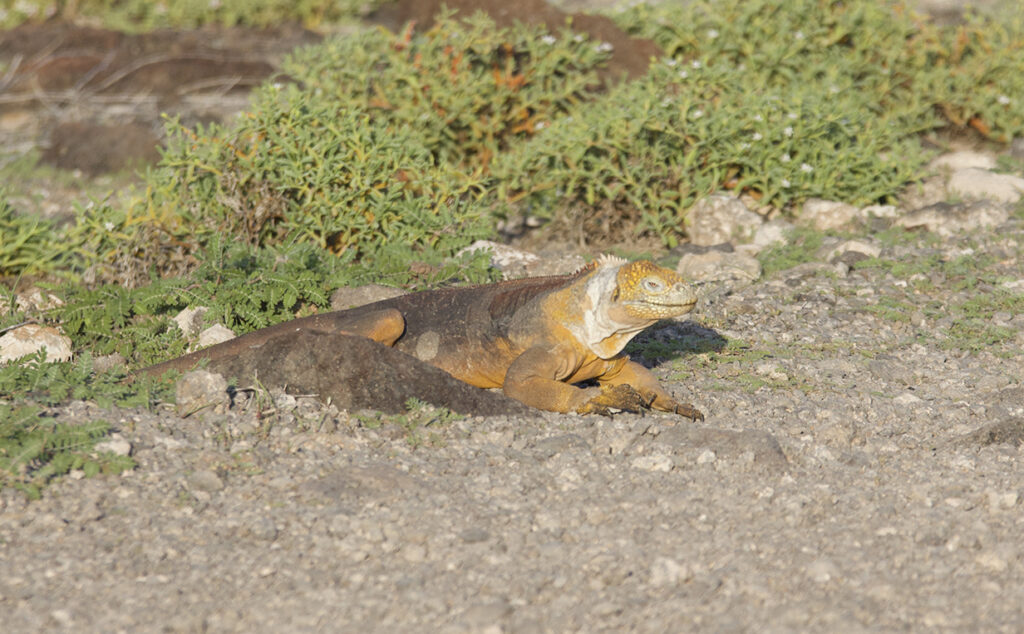
WATCH OUT FOR:
Galapagos Sea Lion, Marine Iguana, Land Iguana, Lava Lizard, Yellowtail Mullet, Sally Lightfoot Crab, Galapagos Shearwater, Red-billed Tropic Bird, Magnificent Frigate Bird, Blue-footed Booby, Nazca Booby, Common Noddy, Brown Pelican, Cactus Finch, Ground Finch.
Pick up time: 7:00 – 8:00 from the hotel or meeting point
Drop off time: 15:30 at the hotel or meeting point
Includes: transportation, naturalist guide and lunch
Recomendation: bring light clothing, sunscreen, a hat, water, comfortable walking shoes, a swimsuit, and snorkeling gear.

